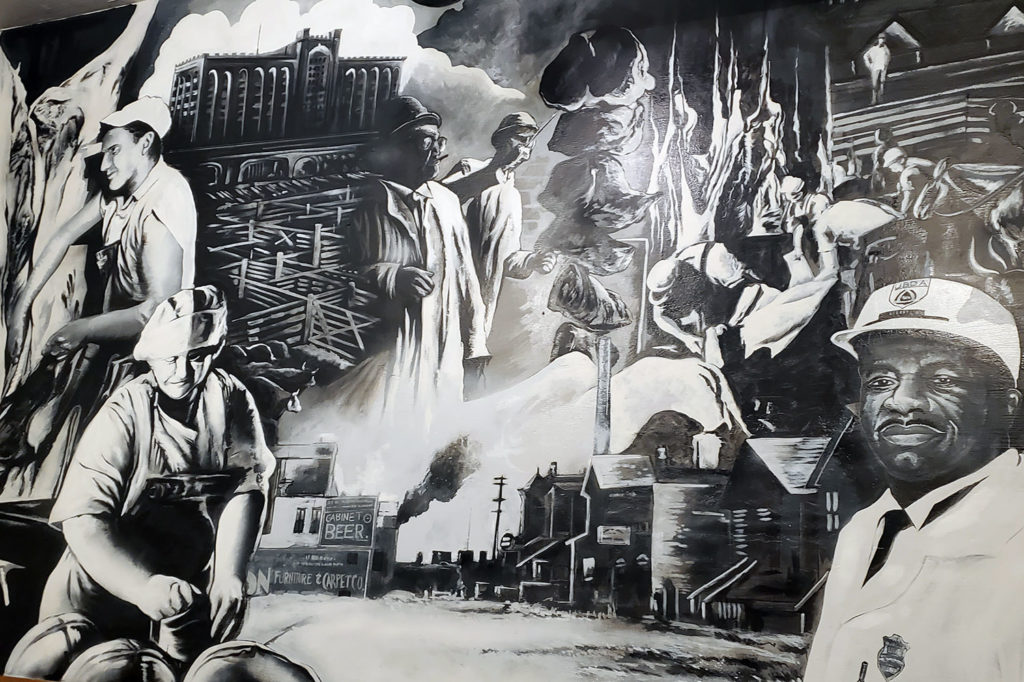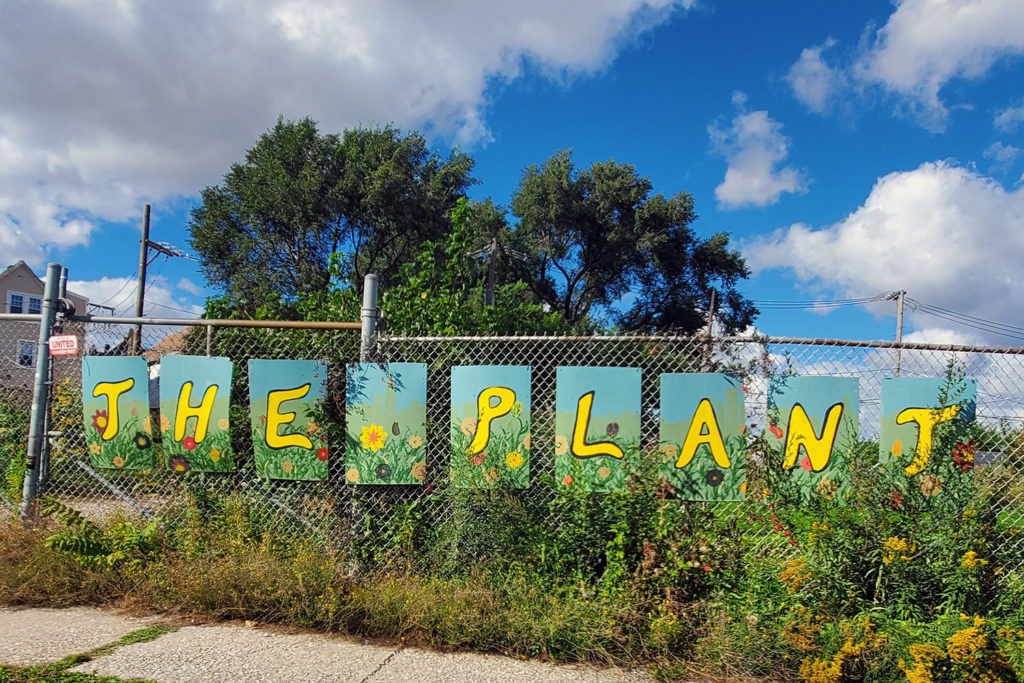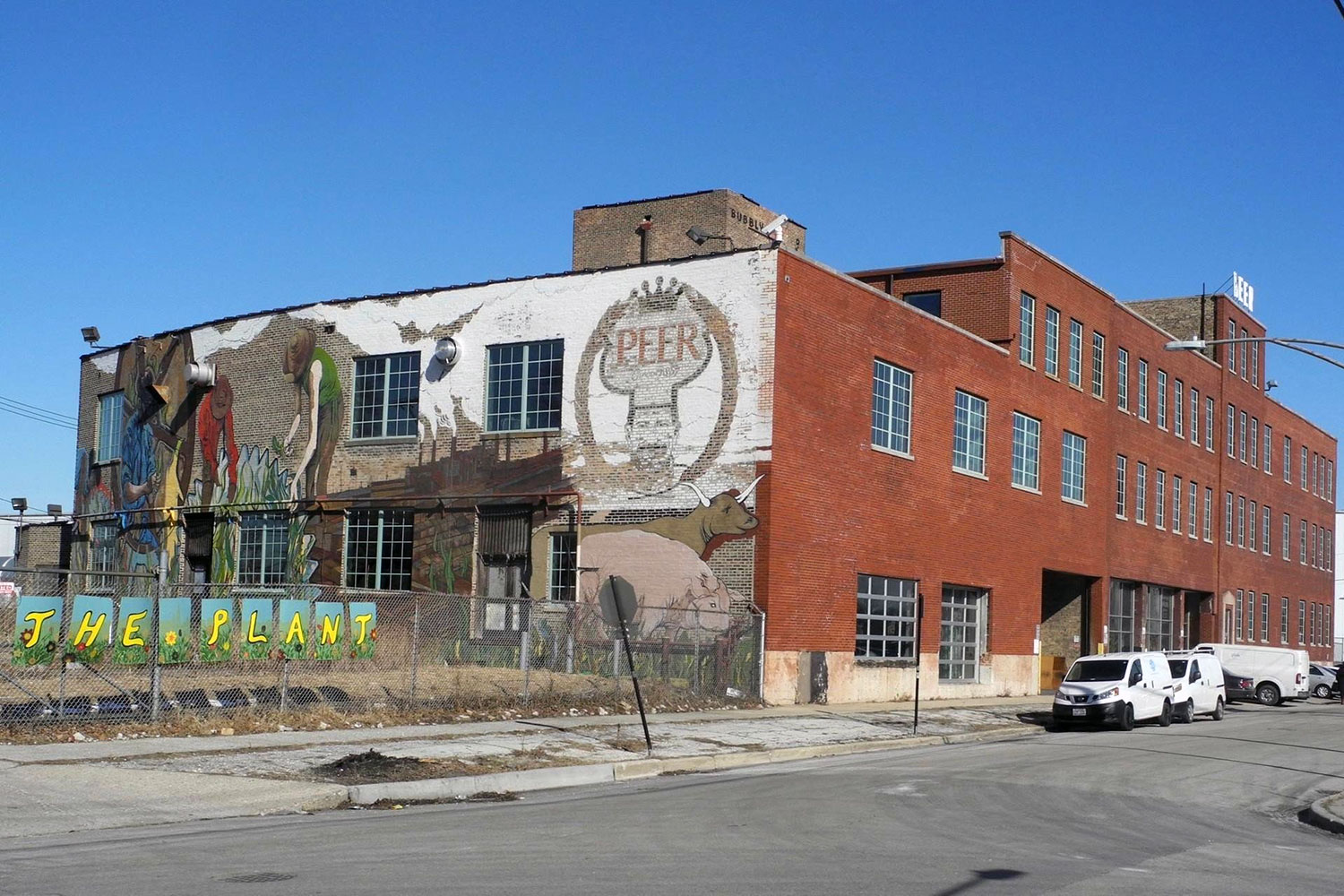Ever since the Union Stock Yard opened in 1865, Chicago has gotten its meals from Back of the Yards. That hasn’t changed, but now that the Stockyards are long gone, the meals themselves have changed.
Peer Foods was a pork packing facility built in 1925 at the corner of 46th Street and Bishop Avenue, to be close to the millions of pigs herded each year through the stockyard gates. The packinghouse outlived the stockyards, continuing to process pig carcasses into pickled pigs’ feet and bacon until 2007, when it abruptly shut down after a merger with an Indiana meatpacker.
The three-story building is still standing, but today it’s the home of The Plant, a consortium of micro food businesses that include a brewer, a cheesemaker, a beekeeper, a chocolatier, and Sacred Serve, which makes gelato from coconut meat and mushrooms. The faded Peer Foods’ mural of a steer and a pig has been augmented with a new painting of urban farmers harvesting lettuce and peas.
In popular stereotype, Chicago is a carnivorous city, devoted to Polish sausage, Italian beef, and hot dogs. Certainly, plenty of meatpackers remain in Back of the Yards, as the scent of bacon wafting through the historic Stock Yard Gate attests. The neighborhood’s last remaining slaughterhouse, Park Packing Co., at 41st and Ashland, ships its wares across the street to Kiki D’s restaurant, which serves them as barbecued ribs and carnitas. But the presence of hydroponic farms growing microgreens and herbs on a site where pigs were once dismembered is some kind of sign that Chicago’s tastes have evolved.
“We have about 15 to 20 small food businesses,” says Carolee Kokola, director of enterprise operations for Bubbly Dynamics, which owns and operates The Plant. “It’s actually kind of sussed out to be mostly vegan, certainly vegetarian. It’s a very different kind of food production facility.”
(On Nov. 12, The Plant will even hold a symposium on The Future of Meat, discussing “the impacts of the meat industry and…alternatives for its future.”)

The Plant’s most future-of-foodistic tenant is Back of the Yards Algae Sciences, which conducts experiments for the uses of algae in its third-floor laboratory. Some of the uses they’ve discovered: food coloring for candy, a heme analogue for meatless hamburgers, and high-protein food additives for sports drinks, chocolates, and pasta. The company employs a mycologist whose work with mushrooms resulted in a collaboration with Whiner Brewery, which operates a tasting room on The Plant’s first floor: a hard seltzer with an algae, wheatgrass, and mushroom extract.
“It’s packed with a lot of stuff,” says Katie Spear, Back of the Yards Algae Sciences’ director of operations. “It has chlorella, spirulina, wheatgrass, and about eight different mushrooms — mushy stuff like that.”
Although it is a hive of post-meat production, The Plant embraces its packinghouse past, at least as an aesthetic, architectural, and historical principle. Pure Foods’ “Pork Chart,” a diagram of the cuts of meat into which a pig can be divided, is still on the wall. So is a black-and-white mural depicting a USDA inspector standing in front of men cutting up carcasses. The smokehouses have been converted to restrooms, with their chrome doors intact.
The Plant also contains the Packingtown Museum, which this magazine named “Best Tiny Museum for Chicago History Buffs.” The one-room display of stockyards and slaughterhouse photos is curated by historian Dominic Pacyga, author of the book Slaughterhouse: Chicago’s Union Stock Yard and the World It Made, Back of the Yards native, and Union Stock Yard employee from 1969 until their closure two years later. As a boy, Pacyga remembered the animal pens smelling like “an open sewer” and cowboys riding through the neighborhood to corral escaped animals. Pacyga worked as a livestock handler, unloading trucks and leading pigs and cattle to pens, where they would wait to be purchased by local slaughterhouses.
“Cattle were easy,” Pacyga says. “They’re not very bright. Pigs are smart. The hogs know. You can tell they know. The loudest kill in the slaughterhouse is the pigs. They squeal like children.”

Running just below the room’s ceiling are metal rails from which pig carcasses once hung. The stockyards are an important part of Chicago history, says Pacyga, because “in 1890, one out of every four Chicagoans were dependent on the meatpacking industry for their income. Five hundred thousand people a year visited the stockyards. They came to see the killing. Everybody knew how to kill an animal if you grew up on a farm.”
By 1971, Pacyga had graduated to security guard. That’s when he heard the report on WGN that the stockyards were closing. The stockyards had been in decline since before World War II. The city’s largest meatpackers — Armour, Swift, and Wilson — had closed. Western cattle breeders were selling directly to slaughterhouses.
“Times change,” says Pacyga. No place illustrates how times have changed for food production in Back of the Yards better than The Plant.



